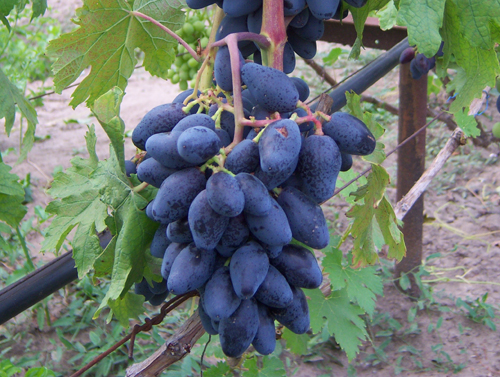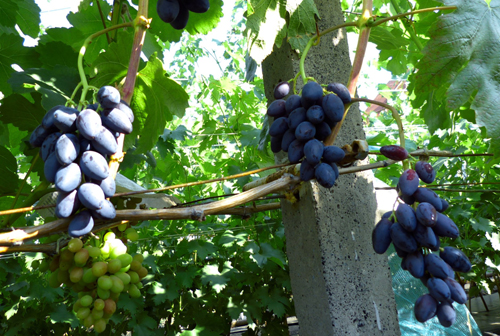Rhombic grape variety
Rhombic is the newest hybrid form of table grapes, bred by the domestic national breeder Yevgeny Pavlovsky just a few years ago. Despite his amateur status, Evgeny Georgievich is an experienced researcher, and for a long period of his creative activity he has already presented dozens of new varieties and hybrids to winegrowers. Some of them turned out to be so successful that they managed to pass the state variety testing and were officially included in the State Register of Breeding Achievements of the Russian Federation. In the first years of work in the field of selection, the most famous scientist in this field, Ivan Aleksandrovich Kostrikin, provided great methodological assistance to Pavlovsky, but even after his death, the folk breeder continued the work he had begun, and never ceases to amaze us with the magnificent properties of his new products.

Bred by crossing a known variety Super Extra with one of the first works of Pavlovsky - Pretty woman, Rhombus turned out to be an ultra-early hybrid, capable of producing crops after only 80-90 days after the start of the growing season. In addition, it is distinguished by a very good appearance of the bunch and an excellent taste of ripe berries. There is little information about the economic characteristics of grapes, but, according to the owners, who are already cultivating the variety on their plots, they did not notice any particular delicacy and pretentiousness for the plants.
The form is gradually gaining popularity among amateurs from all over the country and neighboring countries, but it can be especially interesting for enthusiasts from the northern zone of viticulture, where many other varieties and hybrids often simply do not have time to ripen.
Agrobiological characteristics
Grape bushes have a high vigor of growth, develop rapidly and actively accumulate perennial wood. The crown of a young shoot is open, not pubescent, light green in color. Young leaves are greenish-bronze in color. The formed leaf is large, rounded, usually divided into five lobes with a medium or deep dissection between them. The profile of the leaf blade of Rhombus is slightly funnel-shaped, but the edges of the large lobes are often bent downward. The surface of the leaves is dark green, reticulate-wrinkled, on the reverse side there may be a very weak cobweb pubescence. Top side cutouts are generally deep. Their shape can be very diverse - open in the form of a lyre or with parallel sides, or closed with an egg-shaped lumen or without a lumen at all. The lower notches are generally shallow, slit or V-shaped. The petiole notch is open, vaulted or lyre-shaped with a sharp bottom. Petioles are long, greenish-red due to abundant anthocyanin pigmentation. The denticles along the edges of the leaf blade are very heterogeneous in size, triangular and sawtooth with slightly convex edges and rounded apices. The flowers are bisexual, which allows them to pollinate well in almost any weather, and such unpleasant flaws as pea berries or excessive looseness of bunches were not noticed behind our hero. The annual growth has time to mature perfectly for its entire length, while acquiring a yellowish-brown color. The foliage of the grapes turns bright red before falling off in autumn, which gives the bushes of this variety a very decorative look.

Plants quickly enter the fruiting phase, and already in the second or third year they please caring owners with the first, so-called "signal" bunches. On young bushes, the size of the fruits is usually not outstanding, however, the originator describes the hybrid as very large-fruited, provided that the size of an adult bush is sufficient and a large amount of perennial vegetative mass is sufficient. The best brushes can weigh 800-1000 grams or more. The average mass of Rhombic bunches ranges from 500-600 grams. They hang on light green, long herbaceous comb. The shape of the clusters of grapes is conical, the structure is moderately loose.The berries are very aligned in size, and due to their free arrangement, they do not deform and do not damage each other. The grapes are large, diamond-shaped (which is why the name of the variety came about), black in color with a thick prune bloom on the surface. The average berry weight reaches 10-12 grams or more. Their flesh is dense, pleasantly crunchy when chewed, harmonious neutral taste with a light fruity aroma. Objective data on sugar accumulation and acidity of fruits have not been presented at the moment, however, based on the tasting characteristics, it can be concluded that these parameters are well balanced. The skin of the grapes is relatively thin, easily eaten, but at the same time has a sufficient margin of safety. Seeds of medium size, 1-2 in number for each berry, do not have a particular negative effect when eaten. The general gastronomic ratings of Rhombic on the part of winegrowers are high, and only sophisticated gourmets sometimes complain about the taste that is too simple, in their opinion.
The harvested crop is perfect for fresh consumption, as well as for use as raw materials for home preservation - compotes, preserves, jams and marinades. The dense berry keeps its shape well during processing, and the bright saturated color is transferred to the finished product. The variety may also be of interest to farmers who grow grapes for sale. His bunch has a very attractive presentation, and the very early ripening period of the crop allows you to start selling it during a period of high prices on the market, which undoubtedly ensures good profitability of its cultivation. In addition, the shape is suitable for transporting harvested grapes over long distances without any significant damage and a decrease in aesthetic appeal.

In terms of early maturity, our hero is one of the most outstanding varieties, with a growing season of 80-90 days from the moment the buds open in the spring, until the berries are ready for consumption. In the south, signs of the onset of removable ripeness appear already in mid-July, and by this time the plants receive a very modest sum of active temperatures, not exceeding 2000-2100 ° C. With such indicators, a wide road is open for the hybrid to move to non-traditional northern regions of viticulture, where the cultivation of high-quality varieties is still considered a rarity. The level of SAT necessary for him is characteristic for the latitude of cities such as Yekaterinburg, Moscow, Nizhny Novgorod, due to which the harvest in these regions is able to fully ripen. Certain concerns can be caused only by the insufficient frost resistance of the vine, which is -23 ° C, for non-covering cultivation, however, reliable insulation of grape bushes for the winter removes this problem.
The yield of the hybrid form, according to the author, is high. Winegrowers, however, testing the Rhombic on their plots, so far testify to an increase in the productivity of the new product as it matures and develops. It should be noted right away that it is not worthwhile to heavily load the plants with the harvest from the first years in order to give them the opportunity to develop normally, and not to exhaust their strength due to the impatience of the owner. Full loads should be given only from 4-5 years after planting, but even then it is necessary to carry out rationing by shoots and crops, taking into account the degree of development and vital energy of specific bushes.
After ripening, the grape harvest can remain hanging on the bushes for quite a long time. The berries of this variety are not prone to cracking, as a result of torrential rains or a sharp change in soil moisture. They are also not damaged by wasps, which are too tough for the strong skin of the fruit. The defeat of gray mold usually does not occur, especially if the clarification of the fruit zone of the plants was carried out in advance.The only problem that can worsen the presentation of the late harvest harvest is some rash of berries, caused by the gradual loss of moisture in the sultry summer sun.
Rhombus has increased resistance to fungal diseases, and therefore can be cultivated with several preventive spraying with fungicides. Resistance to root phylloxera has not been studied. Therefore, reproduction in zones infected with this pest is carried out by seedlings grafted onto phylloxera-resistant rootstocks, and in free areas - by root-own cuttings. The rooting of the grapes is very good, as is the fusion with common rootstock forms.








